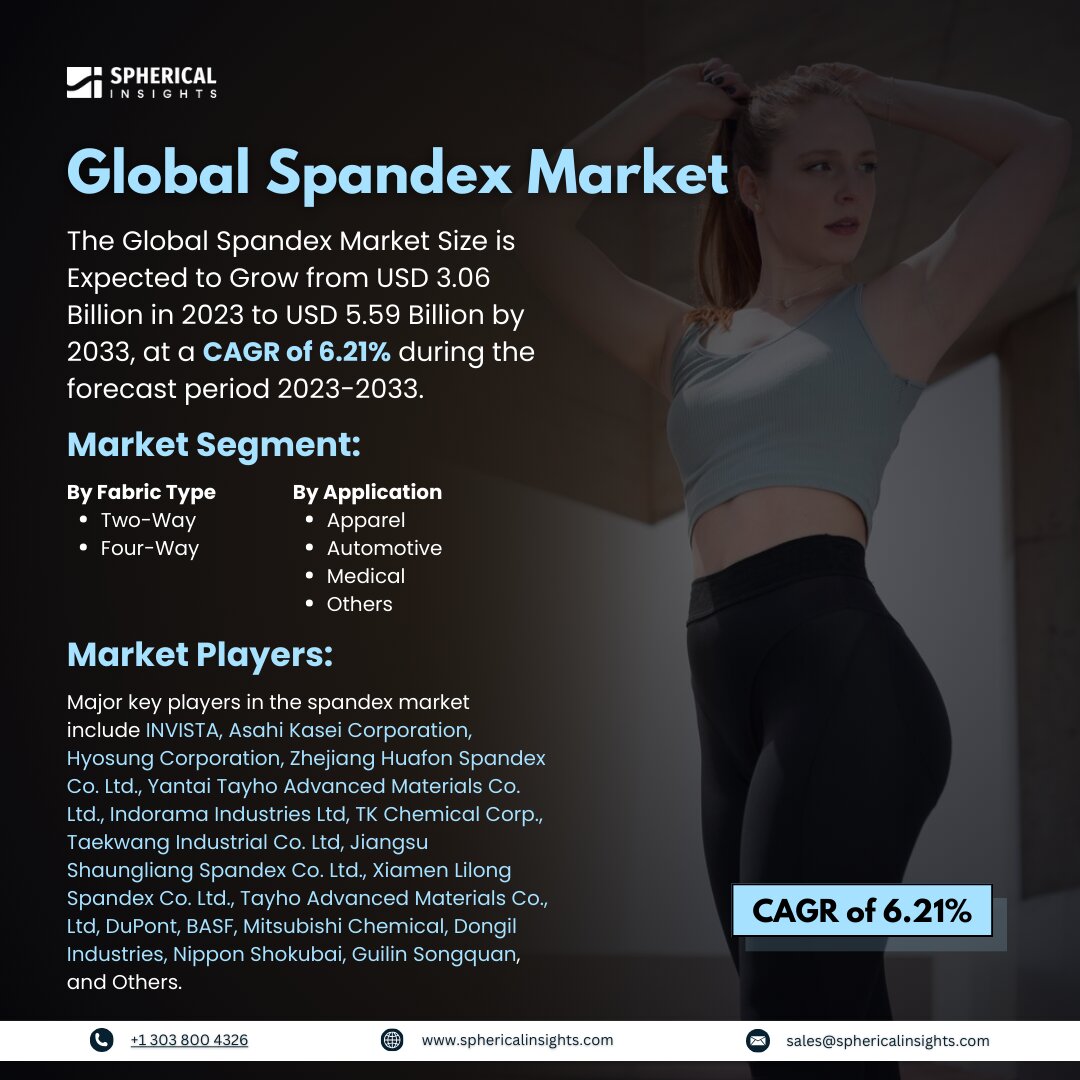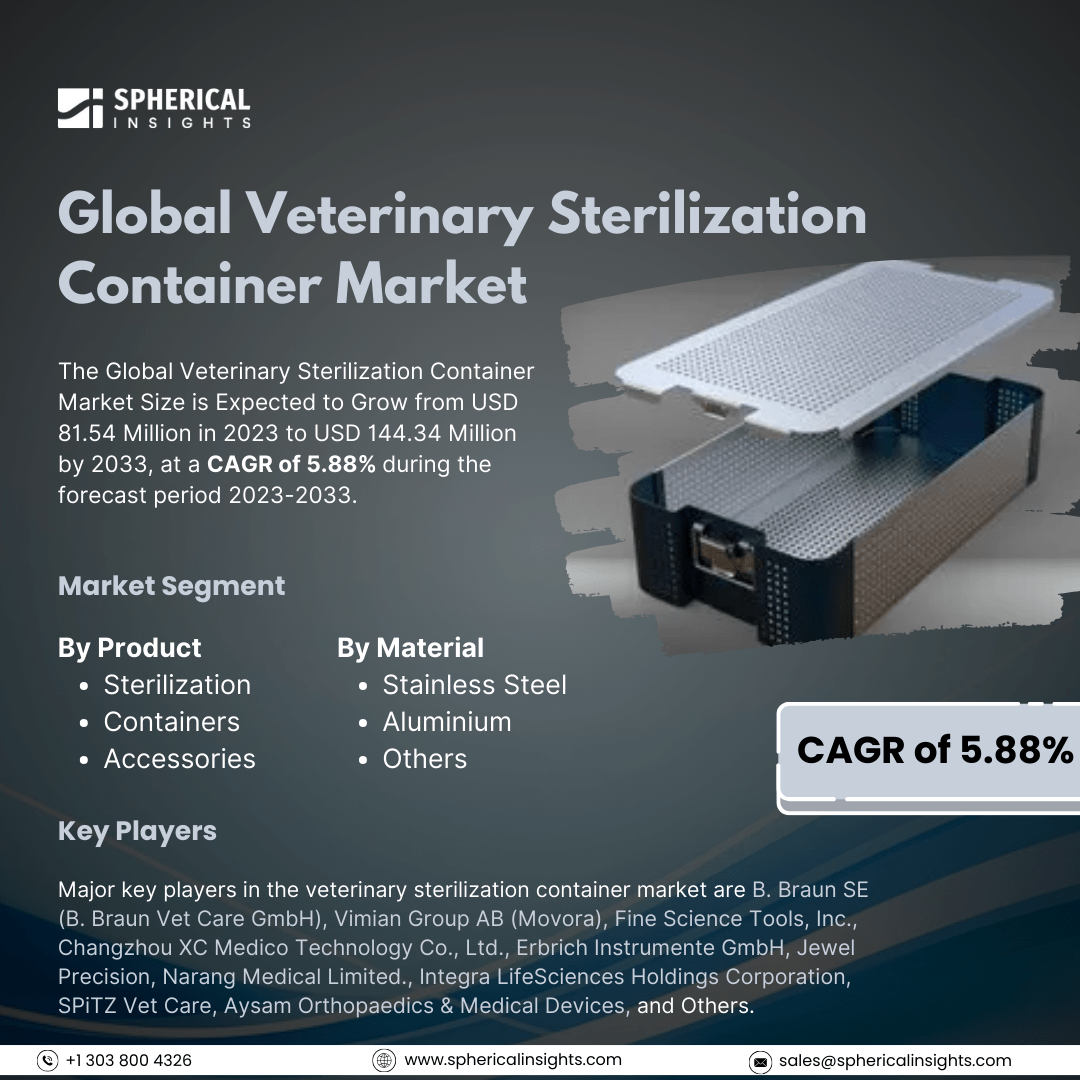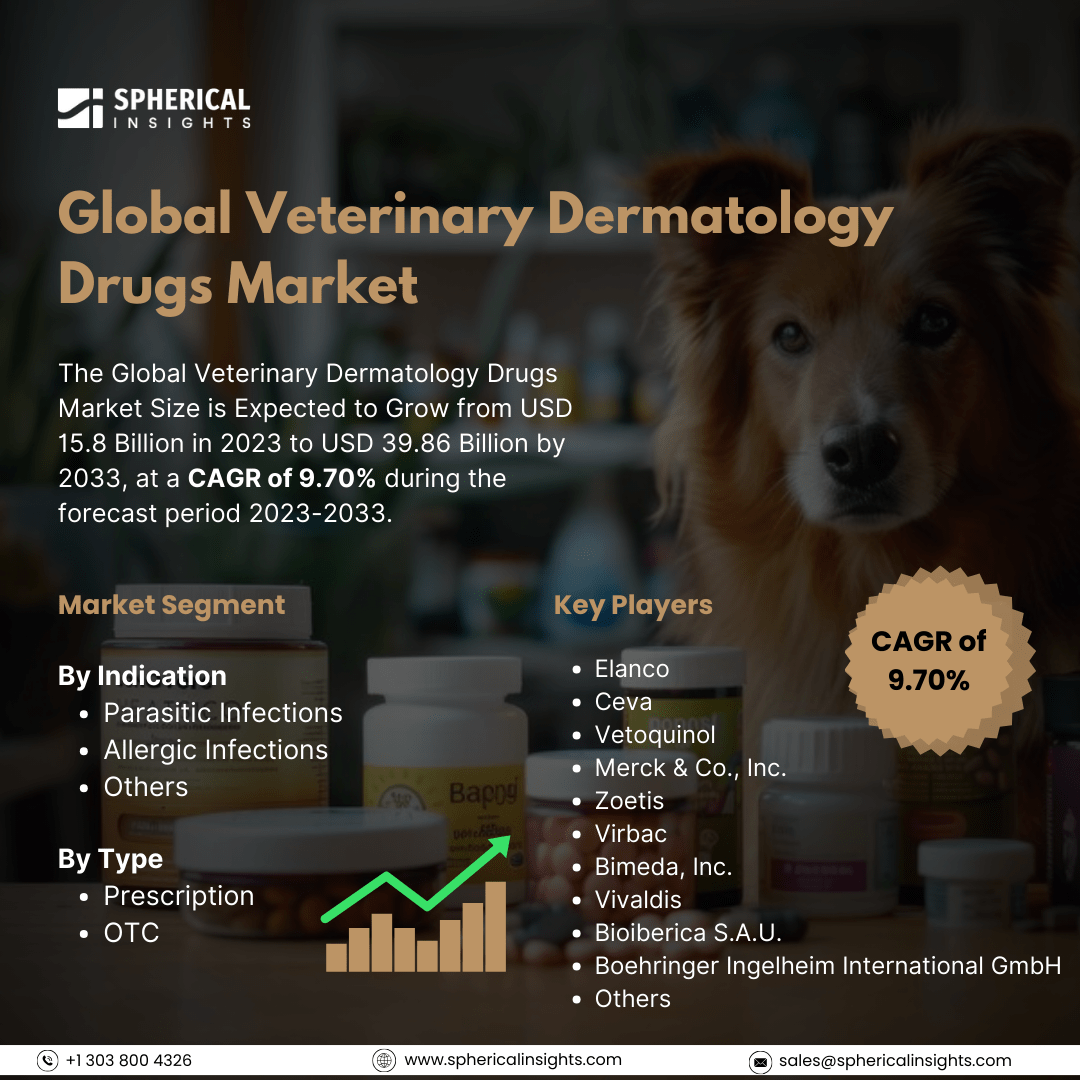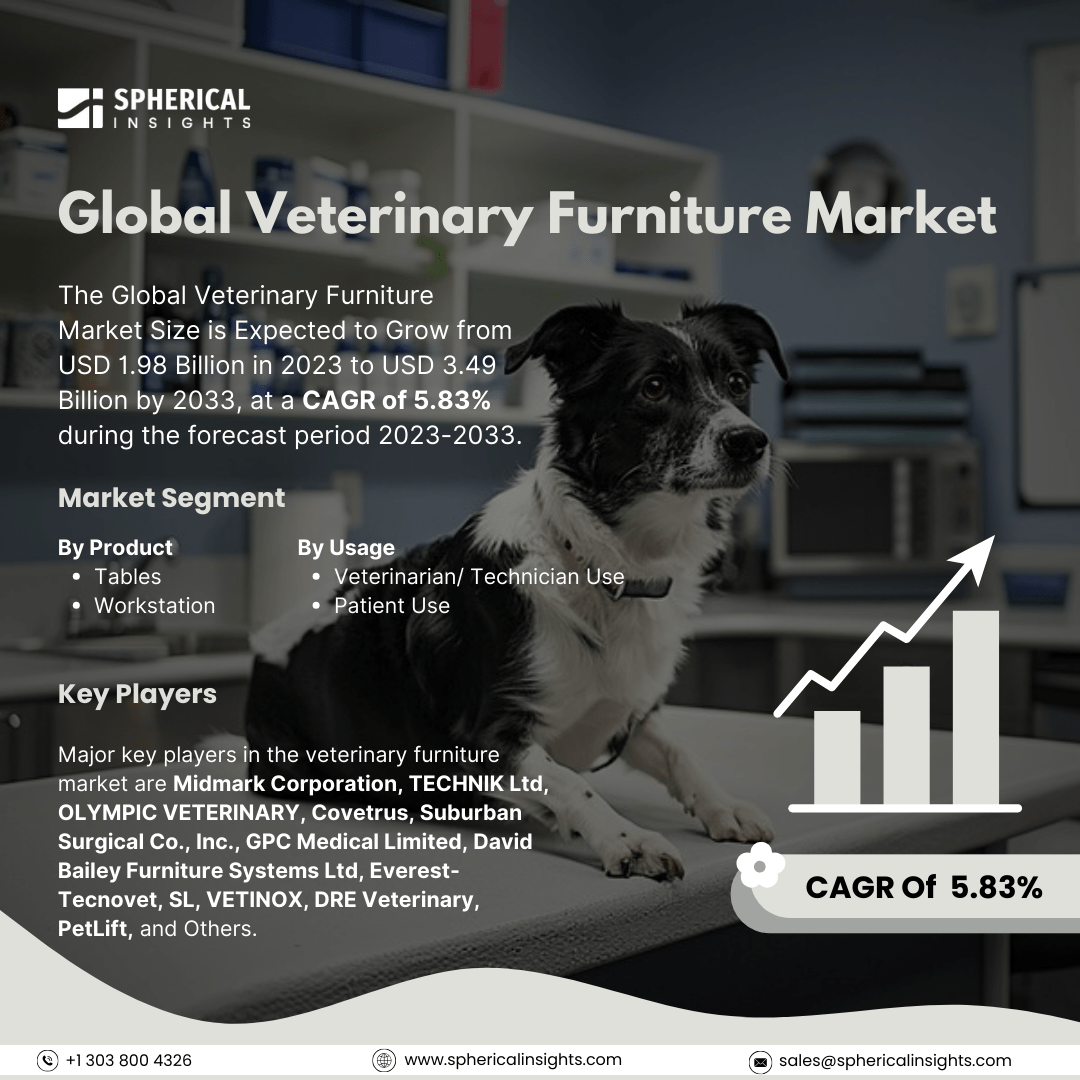Global Spandex Market Size to worth USD 5.59 Billion by 2033
According to a research report published by Spherical Insights & Consulting, the Global Spandex Market Size is Expected to Grow from USD 3.06 Billion in 2023 to USD 5.59 Billion by 2033, at a CAGR of 6.21% during the forecast period 2023-2033.
Browse key industry insights spread across 210 pages with 110 Market data tables and figures & charts from the report on the Global Spandex Market Size, Share, and COVID-19 Impact Analysis, By Fabric Type (Two-Way and Four-Way), By Application (Apparel, Automotive, Medical, and Others), and By Region (North America, Europe, Asia-Pacific, Latin America, Middle East, and Africa), Analysis and Forecast 2023 – 2033.
The manufacturing and distribution of spandex fibers sometimes referred to as elastane or Lycra, comprise the worldwide spandex market. These synthetic fibers are extremely adaptable and frequently utilized in a variety of industries due to their remarkable strength and elasticity. Usually composed of polyether-polyurea copolymers, spandex fibers are used in other textiles to improve their stretch and recovery capabilities. The sports and athletic wear industry has experienced significant growth in recent years due to rising health consciousness and active lifestyles among young people. This has led to a surge in interest in various athletic activities, such as gym workouts, running, yoga, and team sports. High-performance sports apparel, made with spandex fiber, offers comfort, flexibility, and enhanced performance. The popularity of yoga and low-impact workouts has also boosted demand for spandex-infused leggings and pants. Sports compression wear with spandex also provides muscle support and faster recovery post-workout. However, the global spandex market faces challenges due to high manufacturing costs, stringent environmental regulations, and price pressure, limiting profit margins and deterring new players. This reduces incentives for capacity expansion and global competitiveness.
The two-way segment accounted for 73.98% of the market share in 2023 and is expected to grow at a significant CAGR during the forecast period.
Based on the fabric type, the spandex market is classified into two-way and four-way. Among these, the two-way segment accounted for 73.98% of the market share in 2023 and is expected to grow at a significant CAGR during the forecast period. The adaptability of two-way stretch spandex fabrics has led to their considerable demand in the worldwide spandex market. Fabrics that are two-way can stretch both widthwise and longitudinally. This characteristic enables two-way textiles to adapt well to the movement and shape of the body when worn in clothing. They are superior to other textiles in simulating human skin because they hold their shape over numerous washings and wears.
The apparel segment accounted for 33.28% of the market share in 2023 and is anticipated to grow at a CAGR of 9.23% during the forecast period.
Based on the application, the spandex market is divided into apparel, automotive, medical, and others. Among these, the apparel segment accounted for 33.28% of the market share in 2023 and is anticipated to grow at a CAGR of 9.23% during the forecast period. This is because of the growing market for sports and performance apparel. The need for activewear that complements active lifestyles and supports exercise regimens has been driven by significant lifestyle shifts and the fitness boom. Spandex is essential in activewear because it has qualities like flexibility, breathability, and quick drying.
North America is estimated to hold the largest share of the spandex market over the forecast period.
North America is estimated to hold the largest share of the spandex market over the forecast period. The world's biggest producer and user of spandex is the United States. This is explained by the textile and clothing industries' strong presence in the area, especially in the United States. American companies like Nike, Lululemon, and Spanx are significant consumers of spandex due to their wide range of products, which includes sportswear, activity wear, and shapewear.
Asia Pacific is predicted to have the fastest CAGR growth in the spandex market over the forecast period. The fast-growing Chinese textile and clothing manufacturing sector is mostly dependent on imports of spandex, mostly from North America, to satisfy domestic demand. But domestic spandex production in China is also rapidly increasing. Government actions that assist the growth of generic manufacturing sectors lend support to this.
Competitive Analysis
Major key players in the spandex market include INVISTA, Asahi Kasei Corporation, Hyosung Corporation, Zhejiang Huafon Spandex Co. Ltd., Yantai Tayho Advanced Materials Co. Ltd., Indorama Industries Ltd, TK Chemical Corp., Taekwang Industrial Co. Ltd, Jiangsu Shaungliang Spandex Co. Ltd., Xiamen Lilong Spandex Co. Ltd., Tayho Advanced Materials Co., Ltd, DuPont, BASF, Mitsubishi Chemical, Dongil Industries, Nippon Shokubai, Guilin Songquan, and Others.
Recent Development
- In January 2025, Hengju started a 30,000-ton project for differentiated functional spandex in partnership with Hengshen Group. This project ensures great precision and efficiency using automated manufacturing lines and sophisticated intelligent production processes. The new spandex goods include high-elongation, high-resilience, and high-temperature resistant spandex.
Key Target Audience
- Market Players
- Investors
- End-users
- Government Authorities
- Consulting And Research Firm
- Venture capitalists
- Value-Added Resellers (VARs)
Market Segment
This study forecasts revenue at global, regional, and country levels from 2023 to 2033. Spherical Insights has segmented the spandex market based on the below-mentioned segments:
Global Spandex Market, By Fabric Type
Global Spandex Market, By Application
- Apparel
- Automotive
- Medical
- Others
Global Spandex Market, By Regional Analysis
- North America
- Europe
- Germany
- UK
- France
- Italy
- Spain
- Russia
- Rest of Europe
- Asia Pacific
- China
- Japan
- India
- South Korea
- Australia
- Rest of Asia Pacific
- South America
- Brazil
- Argentina
- Rest of South America
- Middle East & Africa
- UAE
- Saudi Arabia
- Qatar
- South Africa
- Rest of the Middle East & Africa



